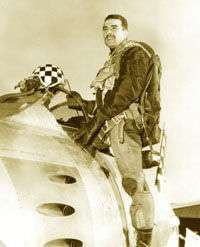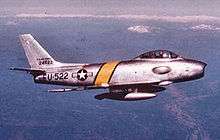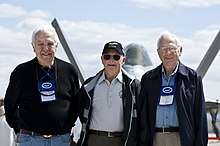Henry Buttelmann
Henry "Hank" Buttelmann (June 26, 1929 – September 16, 2019) was a fighter pilot of the United States Air Force in the Korean War and Vietnam War. He achieved seven victories over enemy aircraft in Korea, making him a flying ace. He gained his fifth kill on June 30, 1953, just after his 24th birthday, which made him the youngest ace of the war.
Henry Buttelmann | |
|---|---|
 Buttelmann with his F-86 Sabre in Korea | |
| Nickname(s) | Hank |
| Born | June 26, 1929 Corona, New York |
| Died | September 16, 2019 (aged 90) Frankfort, Illinois |
| Allegiance | United States |
| Service/ | United States Air Force |
| Years of service | 1952–1979 |
| Rank | Lieutenant colonel |
| Unit |
|
| Battles/wars | |
| Awards | Silver Star Distinguished Flying Cross (4) Air Medal (26) |
| Spouse(s) | Audrey Buttelmann[1] |
Buttelmann was born in Corona, Queens, New York City, and attended the University of Bridgeport for two years. He was sent to Korea in December 1952, flying as a wingman in the F-86 Sabre jet against MiG-15s in "MiG Alley", the area around the border between North Korea and China. He shot down his first plane on June 19 of the next year, and he scored his fifth victory eleven days later. He added two more in July, days before the end of hostilities. He served two tours during the Vietnam War, flying the F-105 Thunderchief and F-100 Super Sabre. He retired from the Air Force in 1979 after a career total of 286 combat missions.
Early life and education
Buttelmann was born to German immigrants[1] on June 26, 1929, in Corona, a neighborhood in the New York City borough of Queens.[2] His first introduction to aviation was when he had a neighbor who was an American Airlines pilot.[3]
He began attending the University of Bridgeport in Connecticut in 1948, and he also served as a private in the 514th Troop Carrier Group of the Air National Guard,[4] after having worked as a lifeguard to save for flying lessons.[1] In 1950 he was called to active duty when the Korean War broke out.[4] He then went to Big Spring Air Force Base in Texas and then Nellis Air Force Base in Nevada for three months of advanced gunnery training.[5][6]
Military career
Korean War

He joined the 25th Fighter-Interceptor Squadron of the 51st Fighter-Interceptor Group[7] in November 1952, where he had to be trained in air-to-air combat because he had only learned air-to-ground at Nellis.[8] He was sent to Suwon Air Base, South Korea, on December 23, where he completed several check flights in the F-86 Sabre before doing his first combat mission on January 15, 1953.[7]
He flew in "MiG Alley", the nickname given to the area around the border between North Korea and China near the Yalu River where American pilots fought Chinese, Soviet, and North Korean MiG-15 planes. The war was winding down into a stalemate by the time Buttelmann arrived, so there were few MiGs in the skies. Because of this, he flew aggressively, venturing north of the Yalu, into Chinese territory, but he still only saw MiGs twice during his first five months, when he was a wingman.[4] On his 50th mission, he came across a formation of MiGs but had to break off because he had reached "bingo" state, which meant he was below the minimum 1,200 pounds (540 kg) of fuel needed to get back to base safely. The airstrip was covered in clouds when he returned, and Buttelmann said he was lucky to have been able to land in those conditions while low on fuel.[8]
On June 19, his 55th mission and first as an element leader (which meant he was in the shooting position), he made his first kill.[7]
His fifth victory came on June 30, 1953, making him a flying ace.[9] He was the USAF's 36th ace[7] and the youngest ace of the war at 24 years and 4 days.[6]
On July 19, he was in a flight of four F-86s led by future astronaut John Glenn that ran into a group of MiGs. In the ensuing skirmish, Glenn, Buttelmann, and Glenn's wingman were each credited with a victory. Glenn said that "the MiGs' tactics were so poor I could only imagine it was a training flight, or they were low on fuel, but we were unbelievably lucky".[10] In another flight with Glenn three days later,[10] he scored his seventh and final victory—also the last day of aerial combat in the war.[11] After coming home from Korea with 65 combat missions,[6] Buttelmann returned to Nellis to serve as an instructor.[5]
Vietnam War
Buttelmann was stationed at McConnell Air Force Base in Kansas when he was sent to Takhli Royal Thai Air Force Base in Thailand in April 1965, after the outbreak of the Vietnam War. As part of the 562d Tactical Fighter Squadron, he logged 46 missions in the F-105 Thunderchief during his four-month deployment. In May 1969, he returned for a twelve-month second tour of duty. In the F-100 Super Sabre, he flew 232 combat missions while commanding the Misty Forward Air Controllers and the 308th Tactical Fighter Squadron.[6]
He retired from the Air Force in October 1979 as a lieutenant colonel,[6] having flown 286 combat missions over the two wars.[5]
Later life

In May 2015, he was awarded the Congressional Gold Medal by Nevada Senator Dean Heller for "his role as an American Fighter Ace during the Korean and Vietnam Wars".[5]
Buttelmann died on September 16, 2019, at the age of 90. He died in Frankfort, Illinois, where he and his wife, Audrey Buttelmann, moved in 2018. Buttelmann was one of two surviving Korean War aces when he died; the other is Charles G. Cleveland[1]
Awards and Decorations
His decorations include:[12]
 |
US Air Force Command Pilot Badge |
| Silver Star | |
| Distinguished Flying Cross with ”V” device and three bronze oak leaf clusters | |
| Air Medal with four silver oak leaf clusters | |
| Air Medal with four bronze oak leaf clusters (second ribbon required for accouterment spacing) | |
| Air Force Commendation Medal | |
| National Defense Service Medal with bronze service star | |
| Korean Service Medal with bronze campaign star | |
| Vietnam Service Medal with four bronze campaign stars | |
| Air Force Longevity Service Award with silver leaf cluster | |
| Republic of Korea Presidential Unit Citation | |
| Republic of Vietnam Gallantry Cross | |
| United Nations Service Medal for Korea | |
| Vietnam Campaign Medal | |
| Korean War Service Medal |
Aerial victory credits
Throughout his career, Buttelmann was credited with seven victories, all of them in the Korean War.
| Date | No. | Type | Location | Aircraft flown | Unit |
|---|---|---|---|---|---|
| June 19, 1953 | 1 | MiG-15 | Uiju, North Korea | F-86 Sabre | 25 FIS |
| June 22, 1953 | 1 | MiG-15 | Yangsi, North Korea | F-86 Sabre | 25 FIS |
| June 27, 1953 | 1 | MiG-15 | Yonsu-dong, North Korea | F-86 Sabre | 25 FIS |
| June 29, 1953 | 1 | MiG-15 | Ch'eyung, North Korea | F-86 Sabre | 25 FIS |
| June 30, 1953 | 1 | MiG-15 | Uiju, North Korea | F-86 Sabre | 25 FIS |
| July 19, 1953 | 1 | MiG-15 | Sakchu, North Korea | F-86 Sabre | 25 FIS |
| July 22, 1953 | 1 | MiG-15 | Tongsong-ni, North Korea | F-86 Sabre | 25 FIS |
| Source:[9] | |||||
See also
References
- Erikson, Briana (September 25, 2019). "Korean War ace, longtime Las Vegas resident Hank Buttelmann dies". Las Vegas Review-Journal. Retrieved September 30, 2019.
- "Valor Awards for Henry Buttelmann". Hall of Valor. MilitaryTimes. Retrieved December 22, 2017.
- Buttelmann, Henry (March 11, 2016). "Lt. Colonel Henry Buttelmann". Chronicles of Courage: Stories of Wartime and Innovation (Interview). Interviewed by Wayne Weiss. Las Vegas, Nevada: Flying Heritage & Combat Armor Museum. Retrieved December 29, 2017.
- Collier, Peter. "Lt. Col. Henry Buttelmann" (PDF). Wings Over the Rockies Air and Space Museum. Retrieved December 29, 2017.
- Heller, Dean (May 13, 2015). "Congratulating Lieutenant Colonel Henry Buttelmann" (PDF). Congressional Record. United States Government Printing Office. 161 (73): S2846. Retrieved December 29, 2017.
- "Henry Buttelmann". National Air and Space Museum. Retrieved December 29, 2017.
- Thompson 2012, p. 65.
- Bledsoe, Larry W. (May 1, 2009). "MiG Hunters". Airport Journals. Retrieved December 22, 2017.
- Maurer, Maurer, ed. (June 1963). USAF Historical Study No. 81: USAF Credits for the Destruction of Enemy Aircraft, Korean War (PDF). Montgomery, Alabama: USAF Historical Division. p. 50. Retrieved December 22, 2017.
- Werrell, Kenneth P. (2005). Sabres Over MiG Alley: The F-86 and the Battle for Air Superiority in Korea. Annapolis, Maryland: Naval Institute Press. p. 195. ISBN 978-1-61251-344-7.
- Seidov, Igor (2013). Britton, Stuart (ed.). Red Devils over the Yalu: A Chronicle of Soviet Aerial Operations in the Korean War 1950–53. Solihull, England: Helion & Company. p. 547. ISBN 978-1-910294-31-4. Retrieved December 29, 2017.
- "First Lieutenant Henry Buttelmann". San Diego Air & Space Museum. Retrieved February 16, 2018.
Bibliography
- Thompson, Warren (2012). F-86 Sabre Aces of the 51st Fighter Wing. Oxford, England: Osprey Publishing. ISBN 978-1-78200-743-2. Retrieved December 29, 2017.CS1 maint: ref=harv (link)